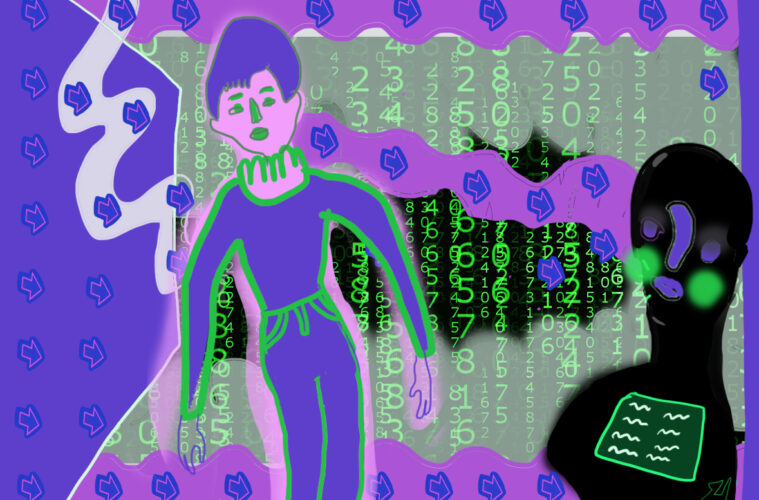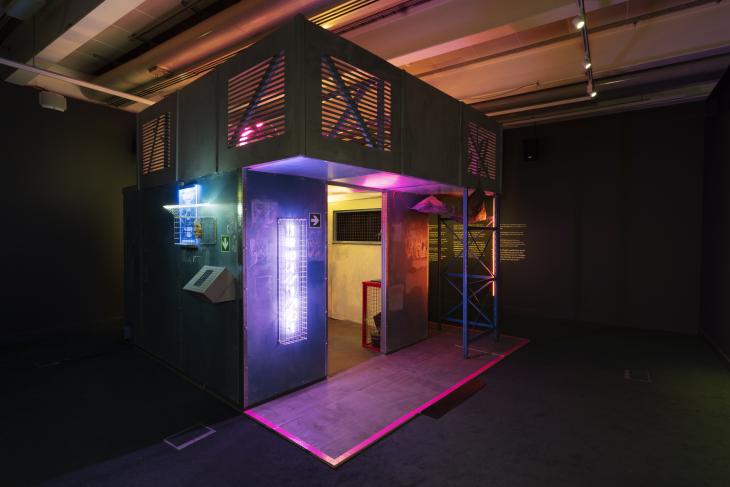A face to open doors at the Imperial War Museum
A month or so ago, I visited the Imperial War Museum in London to see a new exhibition, “Refugees”. As the name suggests, it revolves around a specific theme that is very important to me and to many others. The exhibition looks at refugees’ journeys: beginning with the period following World War One until today. It is extremely powerful and timely. After roughly an hour and a half of looking at pictures and videos that witness a multifaceted set of experiences, I walk into the last room. The room is devoted to A face to open doors, an installation developed by the creative studio Anagram. A face to open doors takes you to a future where border control is overseen by intelligent machines. I decide to try it. I start following the blue arrows on the floor.
Firstly, I have to put my hand in front of a sensor that scans it. It takes a few seconds, and then a voice from the speakers above greets me: “Hello and welcome. That is clearly the hand of someone who has been working hard!”.
The AI and I
The voice is that of a female, but this does not make it any more reassuring. It is a cold, sharp voice. I keep on following the arrows and they take me inside the proper installation, in a tiny space with a screen, a chair and a blind. I pull the blind down behind me, and then it’s just me and the Artificial Intelligence (AI) screener. This distant voice tells me that in order to make sure that I’m not lying about where I come from and the reasons for my journey, I need to undertake a test. The entire process might sound bizarre, maybe even funny now when you’re reading about it, but it’s quite the opposite once you’re in there. The room is dark, illuminated only by the neon lights at the entrance. The farther you progress in your fictional screening, the more absorbed you get.
You feel estranged and alone in front of this test.
After a round of simple questions, the AI shows me a fast sequence of images. They represent all sorts of happy places: a bustling city, a town on the mountains, a sunny beach. I subconsciously smile when I see the image of the beach, as memories of the summer and of warmer times come to my mind. Then the voice tells me that if I pass the test, I’ll be sent to a maritime place, given that my facial expressions showed that the beach was my favourite image. Quite unexpected, as you don’t expect a machine to read your mind, but I keep on going; curious of how the next part of the test might look like.
Emotional test
The AI machine then tells me that in order to verify if I am lying about the information I’ve provided, I need to undertake an emotional test. The voice says that I have to show different emotions through my facial expressions. “Anger, fear, excitement”, it shouts at me, while the screen in front of my face captures my poor efforts of following its orders. I’ve never been a good actress, and it becomes apparent very soon that I’m not doing too well. The percentage of success on the screen doesn’t exceed thirty per cent. As I am sitting there trying to put on my best sad face, I find myself thinking.
“Imagine if you weren’t here on a Friday afternoon with a friend, but you were really coming from a war zone or a situation of distress. Imagine being asked to prove your sufferings through a facial screening. How would you feel?”.
While I’m lost in my thoughts, the voice informs me of my result. “You’ve failed”, it tells me, notifying me that I have not passed the screening and as a consequence, I will not be granted asylum. The screen turns black, the voice goes quiet, and I leave.
Something we should be thinking about
What still amazes me of this installation, weeks after I’ve come across it, is the way it makes you think thereafter. Not only does it create a very vivid and present experience when you’re in the room, it also leaves you speechless and questioning what you’ve been through. I consider myself fairly sceptical of the way border procedures are carried out in most places, and I’ve researched the way asylum seekers are interrogated in countries like Greece and Italy before. Yet I’ve never asked myself, could things become worse in the future?
Is it possible that with the growing pace of technology these people will be treated in an even more inhumane way? And what about the now?
Are the practices currently in place at many borders really more humane than an automated voice? Are we reducing ourselves to selfish machines incapable of feeling empathy, when we silence the calls for help of people who travel to find shelter?
A future not so far away
Above all, A face to open doors prompts you to reflect. It puts you in the shoes of refugees and asylum seekers even if only for a few minutes and disturbs your dozing consciousness. Some countries, like Hungary, Greece or Latvia, are already testing automated procedures at their borders. Artificial Intelligence might speed up checks and queues at airports and train stations. However, the use of these automated machines becomes hugely problematic in terms of human rights and sensibility if applied in the context of border security and migration. A future in which life-changing decisions are taken by technology might be not so far away. Preventing this scenario is in the interests of all of us if we are to maintain the compassion that makes us human.
Written by Elena Siniscalco.
Elena is a Master’s Student in International Journalism at City University, London. She loves reading and writing about anything at any time. Especially about politics and humanitarian questions.



